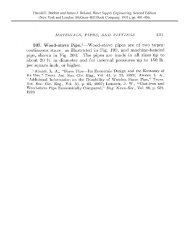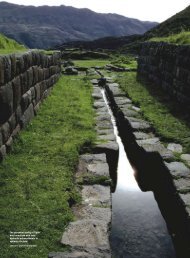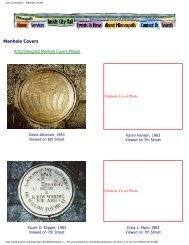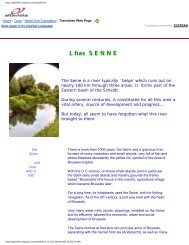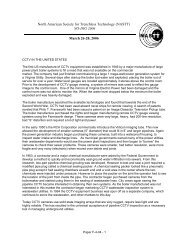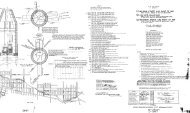The Water Supply and Distribution System of the Nabataean City of ...
The Water Supply and Distribution System of the Nabataean City of ...
The Water Supply and Distribution System of the Nabataean City of ...
You also want an ePaper? Increase the reach of your titles
YUMPU automatically turns print PDFs into web optimized ePapers that Google loves.
Figure 5a. Piping elements on <strong>the</strong> north side <strong>of</strong> <strong>the</strong> Siq.<br />
supplemented, as required by occasional dem<strong>and</strong>, by<br />
<strong>the</strong> long Jebel el Khubtha pipeline from <strong>the</strong> Zurraba<br />
reservoir.<br />
Supplemental water-supply systems <strong>and</strong> watersupply<br />
redundancy<br />
Cisterns <strong>and</strong> dams on Jebel el Khubtha (Akasheh 2003)<br />
(C;2) captured <strong>and</strong> stored rainfall run<strong>of</strong>f. Some <strong>of</strong> <strong>the</strong><br />
upper-level cisterns appear to have channels leading<br />
to ground-level cisterns that fed urban housing or field<br />
areas to <strong>the</strong> west <strong>of</strong> Jebel el Khubtha, supplementing<br />
Charles R. Ortl<strong>of</strong>f<br />
Figure 5b. Channel trough on <strong>the</strong> north side <strong>of</strong> <strong>the</strong> Siq for placement <strong>of</strong><br />
piping.<br />
100<br />
<strong>the</strong> water supply from <strong>the</strong> Zurraba<br />
system. Intermittent springs located<br />
on Umm el Biyara (A; 1,2) may also<br />
have been important in ancient<br />
times; <strong>the</strong> Arabic name for this<br />
mountain translates as ‘Mo<strong>the</strong>r <strong>of</strong><br />
Springs’. As previously mentioned,<br />
<strong>the</strong> Siq open channel was ab<strong>and</strong>oned<br />
in late <strong>Nabataean</strong> phases <strong>and</strong><br />
replaced by a pipeline system (Figs.<br />
5a & b) that extended to <strong>the</strong> area opposite<br />
<strong>the</strong> <strong>the</strong>atre district (B;1) <strong>and</strong><br />
ended at <strong>the</strong> Nymphaeum. Thus at<br />
least two separate supply lines led to<br />
<strong>the</strong> Nymphaeum to ensure supply<br />
redundancy. <strong>The</strong> construction <strong>of</strong><br />
<strong>the</strong> Siq pipeline system is generally<br />
attributed to Malichus II or his<br />
predecessors, Aretas IV or Obodas<br />
III, in <strong>the</strong> first century BC or early<br />
first century AD (Guzzo & Schneider<br />
2002). <strong>Water</strong> dem<strong>and</strong>s south <strong>of</strong><br />
Wadi Mousa were high on account<br />
<strong>of</strong> <strong>the</strong> nearby marketplace, <strong>the</strong>atre,<br />
temple <strong>and</strong> housing districts <strong>and</strong><br />
significant water resources were<br />
available from <strong>the</strong> north side piping<br />
systems. A pipeline connection<br />
from <strong>the</strong> Nymphaeum to this<br />
area was <strong>the</strong>refore a logical use<br />
<strong>of</strong> surplus water for development<br />
<strong>of</strong> this area. A bridge most likely<br />
carried water from <strong>the</strong> north side<br />
<strong>of</strong> <strong>the</strong> Jebel el Khubtha system in<br />
<strong>the</strong> El Hubtar Necropolis area (20<br />
in B;2) across <strong>the</strong> Wadi Mousa in<br />
<strong>the</strong> vicinity <strong>of</strong> <strong>the</strong> <strong>the</strong>atre (19 in<br />
B;1) but all traces are lost owing to<br />
extensive erosional flood damage.<br />
In addition to water delivered by<br />
<strong>the</strong>se means, <strong>the</strong> <strong>the</strong>atre supply was<br />
supplemented from large, upper-level reservoirs in <strong>the</strong><br />
Wadi Farasa area <strong>and</strong> pipelines originating from Ain<br />
Braq <strong>and</strong> Ain Ammon sources (Fig. 1). <strong>The</strong>se again<br />
indicate built-in supply redundancy from multiple<br />
sources. Some <strong>of</strong> <strong>the</strong> larger reservoirs, <strong>the</strong>refore, appear<br />
to function in connection with a spring supply<br />
system <strong>and</strong> are situated to collect seasonal rainwater<br />
run<strong>of</strong>f. Reservoirs, <strong>the</strong>refore, were mainly to provide<br />
water for occasional peak requirements through piping<br />
or channel systems. Surface cisterns, on <strong>the</strong> o<strong>the</strong>r<br />
h<strong>and</strong>, appear to be opportunistically placed to collect<br />
rainwater run<strong>of</strong>f; o<strong>the</strong>r than seasonal rain recharge,




